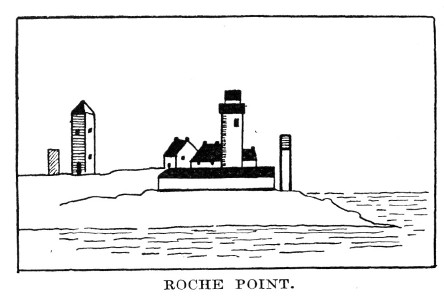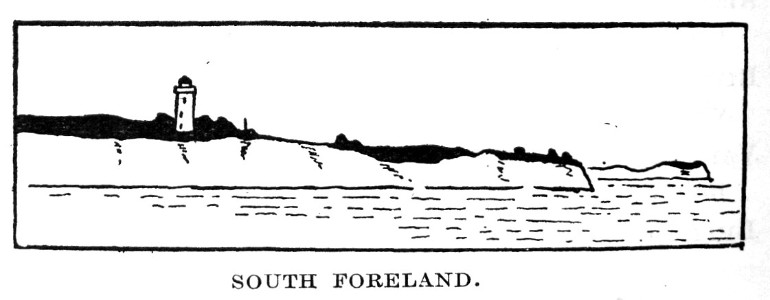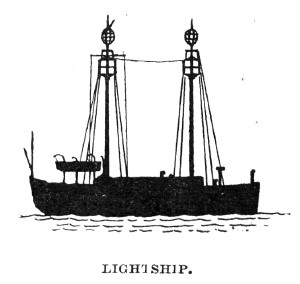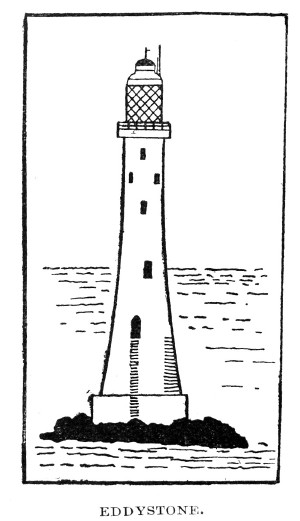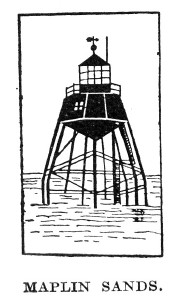| Web
and Book design,
Copyright, Kellscraft Studio 1999-2007 (Return to Web Text-ures) |
 (HOME)
|
|
11 Lights and
Lighthouses LIGHTHOUSES, or
beacons for the aid of the navigator, have been in existence since B.C. 331,
when the famous Pharos of Alexandria was first built. In the British
Isles some slight remains of a lighthouse, which must have been built during
the Roman invasion, are yet to be seen at Dover. The earliest form
of lighthouse was that of a tower or beacon, on the top of which wood or some
other fuel was burned in a brazier or iron basket; an arrangement which, with
but very slight modification and improvement, existed in various parts of the
world until well into the nineteenth century. The form of the
modern lighthouse varies with circumstances. When founded upon an isolated
rock, as in the case of the Eddystone, or of the Bishop's Rock in the Scilly
Islands, which may at certain states of the tide be wholly or partly submerged,
it is either built of masonry, which rests directly upon the rock, or the
foundation is sunk into the rock itself. The solid foundation of the tower is
carried a score or so of feet above the surface of the water, when it is
surmounted by a hollow tower in which the various rooms for the accommodation
of the keepers are situated, and in this form it is continued to the top, in
which is placed the lantern. In an estuary, or
upon a spit or tongue of sand off shore, resting upon screw piles, the form
usually adopted is that of a broad-based structure; and on the shore at the
foot of a cliff, where the full force of the wind is likely to be felt, a
strong structure of masonry, similar to that of the rock-built lighthouse, is
the kind usually constructed; whilst on the top of a cliff, beyond the reach of
the action of the waves, an ordinary brick or stone tower suffices. This latter
form of lighthouse is usually connected with the keepers' rooms, which in this
case form a separate structure of themselves. The object of a
lightship is to indicate the presence of a dangerous shoal, where it would be
difficult to secure a foundation for a stationary structure. A lightship,
therefore, in addition to performing the function of a shore lighthouse, has
the advantage of being situated right over the spot against which it is desired
to warn the mariner. The lights of
lighthouses have undergone great development from the early days of the wood
flare to the electric light of to-day. The early wood or tow-burning beacons
were succeeded by candles and oil-lamps, the power of which latter at first was
scarcely more effective than the former. In somewhat more modern times,
however, Argand and Rumford, by the invention and development of new appliances
for the burning of mineral or animal oil, effected considerable improvement,
and gas has likewise been used with good results. The electric light
has, by its great power, overcome much of the want of penetration of the
earlier oil lights, although its power of penetration has proved to be less,
comparatively speaking, in a foggy atmosphere than in clear weather. But this
objection, and the fact that it is more costly than gas to operate with, are
practically the only arguments that can be brought against it. To concentrate the rays
of the lamp and disperse them in the desired direction, Thomas Stevenson — the
honoured ancestor of the famous novelist — in 1849 employed a lens in front of
a reflector, which combined both the direct and the reflected rays into one
parallel beam. This light, being a combination of refractor and reflector,
produces a light of the "catadioptric" class as distinct from the
single reflector, which consists of a small glass mirror, or, in its improved
form, of parabolic metal reflectors. This class is known as
"catoptric." In 1822 Fresnel
introduced the "dioptric" system, in which refraction only is used,
the direct rays being sent forth through a spherical lens, surrounded by a
series of annular or parabolic prisms. The lights of
England and Wales are under the control of the Trinity House Brethren, which
was incorporated in 1514, and first controlled the lights in 1680. In Scotland
the lights are under the care of the Northern Lighthouse Board (since 1786),
and in Ireland the Irish Lighthouse Board perform the same service. The distances here
given, from which the lights are visible, are calculated for a height of 15
feet above the sea. Lightships
belonging to the Trinity House, London, are coloured red. F. Fixed. A
continuous steady light. Fl. Flashing. A
single flash, the duration of darkness (or eclipse) being always greater than
that of the light. Gp. Fl. Group
Flashing. Groups of two or more flashes in succession (not necessarily of the
same colour) separated by eclipses. F. and Fl. Fixed
and Flashing. Fixed light varied by a single white or coloured flash, which may
be preceded and followed by a short eclipse. F. and Gp. Fl.
Fixed and Group Flashing. The same as the preceding, but with groups of
flashes. Rev. Revolving.
Light gradually increasing to full effect, then decreasing to eclipse. Occ. Occulting. A
steady light with sudden and total eclipse at regular intervals, the duration
of the light being always equal to or greater than that of the darkness. Gp. Occ. Group
Occulting. A steady light with groups of two or more sudden and total eclipses
at regular intervals. Alt. Alternating.
Alternating lights of different colours (generally red and white), without any
intervening eclipse. English Channel SCILLY
ISLANDS. Bishop Rock.
White Group Flash (1 min.) vis. 18 miles. St. Agnes. White Rev. (½ min,),
visible 8 miles. Round Island. Red Fl. (½ min.), visible 20 miles. SEVEN STONES
LIGHTVESSEL. — Group flash, white, 3 times in quick succession, followed by 36
sec. dark. Red hull, ball at mast-head, visible 1 miles. LONGSHIPS
(Land's End). — Occ. (1 min.) white, red sectors. Fog explosive. WOLF ROCK. —
Rev. (½ min.), alternate red and white, visible 16 miles. Fog bell. LIZARD. —
Two fixed white (74 yards apart), visible 21 miles. ST.
ANTHONY'S (Falmouth). — One fixed white, visible 11 miles, and one white rev.
every 20 sec., visible 14 miles. Fog bell. EDDYSTONE. —
White group flash (2 successive flashes of 2½ sec. each, divided by eclipse of
4 sec., the second flash followed by 21 sec. ecl.) visible 17 miles; also a
fixed white subsidiary in lower window, visible 15 miles. START POINT.
— White, rev. every minute, Visible 20 miles; also fixed white in same tower,
Visible 20 miles. PORTLAND
BILL. — Two fixed white, 503 yards apart , visible 21 and 18 miles. SHAMBLES
LIGHTVESSEL. — White group flash, 30 sec., visible 11 miles. Red hull, ball at
masthead. CASQUETS. —
White group flash, 3 successive flashes of 2 sec., each followed by 3 sec.
ecl,, and the 3rd by 78 sec, eclipse, Visible 17 miles. ANVIL POINT.
— White flash, 10 sec., visible 18 miles, NEEDLES. —
Occ., white, red and green sectors, eclipsed for 3 sec., every minute, visible
14 miles. ST.
CATHARINE'S (Isle of Wight). — White flash, red sector, every 30 sec., visible
17 miles. Fog siren, one. OWERS
LIGHTVESSEL. — Rev. white and red alternately, every min., visible 11 miles.
Red hull, ball at masthead. BEACHY HEAD.
— White group flash every 20 sec., first flash, sec.; eclipse, 2¾ sec.; second
flash, sec.; eclipse, 16¼ sec.; Visible 16 miles. ROYAL
SOVEREIGN LIGHTVESSEL. — White group flash (3 flashes occupying 45 sec.,
eclipse 31½ sec., visible 11 miles. Red hull. Ball, with small ball above, at
masthead. DUNGENESS. —
One fixed white and red, Visible 16 miles; one white flash 5 sec,, Visible 10
miles. WARNE
LIGHTVESSEL. — Red rev. 20 sec., Visible 11 miles. Red hull, ball at masthead. DOVER. — On
Admiralty Pier. White F. and Fl., 71 sec., visible 10 miles. Pier Works
Lightvessel. — White flash, 30 sec., visible 10 miles. SOUTH
FORELAND. — Two fixed white, 385 yards apart, visible 26 and 23 miles. GOODWIN. South
Goodwin Lightvessel. — White group flash, 2 flashes occupying ½ min., followed
by 17½ eclipse. Visible 11 miles. Red hull. Ball at masthead. East Goodwin
Lightvessel. — Green rev., 15 sec., visible 11 miles. Red hull. Inverted
triangle over diamond on mast. Gull
Lightvessel (in fairway). — White rev. 20 sec., visible 10 miles. Red hull,
ball at masthead. North
Goodwin Lightvessel. — Three quick white flashes in succession, followed by 36
sec. eclipse. Visible 11 miles. Red hull. Three masts, with ball on each. NORTH
FORELAND. — White, red sector, disappearing every min. for 5 sec. Visible 20
miles.
TONGUE
LIGHTVESSEL. — Group flash red and white every min., visible 11 miles. Red
hull. Ball at masthead. NORE
LIGHTVESSEL. — White rev. every min., visible 10 miles. Red hull. Ball at
masthead. MOUSE
LIGHTVESSEL. — Green rev. every 20 sec., visible 11 miles. Red hull. Ball at
masthead. MAPLIN SAND.
— OCC. red, with white sector; ( min.); visible 11 miles. SWIN MIDDLE
LIGHTVESSEL — White rev. 30 sec., visible 10 miles. Red hull. Ball at masthead.
SUNK
LIGHTVESSEL. — Rev. every 45 sec., alternate red and white, visible 11 miles.
Red hull. Half ball flat side down over another at masthead. KENTISH
KNOCK LIGHTVESSEL. — White rev. every minute, visible 11 miles. Red hull. Small
ball over another at masthead. GALLOPER
LIGHTVESSEL. — Red group flash every 45 sec., visible 11 miles. Red hull. Two
cones pointing upward on main and ball on jigger mast. DOVERCOURT.
— One fixed white, Visible 11 miles; one fixed white, visible 9½ miles, 208
yards apart. HARWICH
(JETTY). — One fixed white, red sector. SHIPWASH
LIGHTVESSEL. — White group flash, 3 flashes, followed by 14 sec. eclipse,
occupying 30 sec., Visible 11 miles. Red hull, ball at masthead. ORFORDNESS.
— Occ. white, red and green sectors, 40 sec., visible 15 miles. OUTER GABBARD
LIGHTVESSEL. — White group flash, 4 flashes every min., visible 11 miles. Red
hull. Inverted cone at masthead. SOUTHWOLD
(Centre). — Group Occ. white, red sectors, 20 sec., visible 17 miles. LOWESTOFT. —
High Light on Cliff. White rev. every 30 sec., visible 17 miles. In same tower
fixed red sector. Low light (747 yards away); occ. red and white sectors every
30 sec., Visible 11 miles. YARMOUTH. —
"Caister Leading Lights," at Sailors' Home and Pier. Two fixed red,
Visible 13 and 9 miles. COCKLE LIGHTVESSEL.
— White rev. every minute, visible 10 miles. Red hull. Ball at masthead. CROMER. —
White rev. every minute, visible 23 miles. HUNSTANTON.
— White, red sector. Group Occ. every 30 sec., visible 16 miles. DUDGEON
LIGHTVESSEL. — White and red group flash, every 2 min., visible 10 miles. Red
hull. Ball at masthead. INNER
DOWSING LIGHTVESSEL, — Green rev. every 20 sec., visible 11 miles. OUTER
DOWSING LIGHTVESSEL. — Red rev. 30 sec., visible 11 miles. Red hull. Half ball
over ball at masthead. SPURN HEAD
(mouth of Humber). — White flash 20 sec., visible 17 miles (flash 2 sec.,
eclipse 18 sec.). In same tower fixed White and red, visible 13 miles. FLAMBOROUGH
HEAD. — Rev. white and red every 90 sec., visible 21 miles (2 white and 1 red
to each rev.). SCARBOROUGH
— OCC. every 8 see,, white, red sector, visible 13 miles. WHITBY (Ling
Hill). — Occ. white and red, every 30 sec., visible 22 miles. TEES RIVER
(Southgare Breakwater). — One white flash, red sector, 12 sec. Visible 10
miles. HARTLEPOOL
(Heugh). — Two in one tower, Occ. white every 5 sec., visible 15 miles; fixed
red, visible 4 miles. SUNDERLAND
(Inner N. Pierhead). — Two fixed (upper white, lower red) in one tower, visible
13 miles and 6 miles. COQUET. —
One Occ. white and red sectors, every min., with eclipse of 2½ sec., visible 14
miles. One fixed White and red sectors (same tower), visible 13 miles, FARN ISLANDS
(Longstone). — One white, rev. every min., visible 14 miles. BERWICK-ON-TWEED
(Pierhead). — Two fixed, white and red, visible 12 miles and 8 miles.
ST. ABB's
HEAD. — One white flash every 10 sec., visible 21 miles. FIDRA
ISLAND. — White group flash every 15 sec., visible 17 miles. INCH KEITH.
— White rev. every 30 sec., Visible 21 miles. NORTH CARR
LIGHTVESSEL. — Fixed white, visible 11 miles. Red hull, with red conical cage. BELL ROCK. —
White and red flash alternately every min., visible 15 miles. ST. ANDREW'S
(Pierhead). — One fixed white and red and green, visible 6 miles. RIVER TAY. Buddonness.
— Two fixed white, 401 yards apart, visible 16 miles and 13 miles. Port-on-Craig
High Light and Pile Light. — Two fixed white, 1,700 yards apart, visible 12
miles and 10 miles. TOD HEAD. —
White group flash every 30 sec., visible 17 miles. GIRDLENESS,
— White group flash (2 flashes every 20 sec.), visible 19 miles. ABERDEEN (N.
Pierhead). — One fixed white, visible 8 miles. BUCHAN NESS.
— One white flash every 5 sec., visible 17 miles. PETERHEAD
(S. Harbour), — Fixed white and red, visible 10 miles. RATTRAY
HEAD. — White group flash every 30 sec,, visible 15 miles. KINNAIRD
HEAD. — Fixed white and red, visible 17 miles. COVESEA
SKERRIES. — Rev. white, with red sector, every minute, visible 18 miles. INVERNESS
(Thornbush Pier). — Two fixed red. TARBET NESS.
— White group flash every 30 sec., visible 18 miles. NOSS HEAD. —
Rev. White, with red sector, every 30 sec,, visible 18 miles. PENTLAND
SKERRIES. — White group flash every 15 sec., visible 19 miles. DUNNET HEAD.
— One fixed white, visible 24 miles. ORKNEYS. Noup Head. —
White group flash, every minute, visible 22 miles. Skroo. —
White group flash (2 flashes every 30 sec.), visible 23 miles. SHETLAND
ISLANDS (Sumburgh Head). — One fixed white, visible 24 miles. CAPE WRATH.
— White and red rev. alternately every 3 sec., eclipse 57 sec., visible 27
miles. HEBRIDES
(Butt of Lewis). — Fixed White, visible 19 miles. STORNOWAY
(Arnish Point). — White rev. every 30 sec., visible 13 miles. SKERRYVORE.
— White rev. every minute, visible 18 miles. DUART POINT
(William Black Memorial Tower). — Group flash white and red sectors, 3 flashes
every 15 sec., visible 12 miles. PLADDA
ISLAND (Fladda), N. — Fixed white and red, visible 11 miles. MULL OF
CANTYRE. — Fixed White, visible 24 miles. SANDA. —
White flash every 24 sec., visible 18 miles. PLADDA
ISLAND (off S.E. point of Arran). — White group flash every 30 sec., visible 17
miles. LAMLASH
(S.W. point of Holy I.). — One fixed green over red, visible 12 miles. CUMBRAE (W.
of Little Cumbrae Island). — White group flash, 2 quick flashes every 30 sec.,
visible 19 miles. ARDROSSAN
(S. Breakwater). — Occ. white and red (2 sec. flash and 2 sec. eclipse),
visible 10 miles. AILSA CRAIG.
— White group flash, 6 flashes in 15 sec., eclipse 15 sec., visible 13 miles. MULL OF
GALLOWAY. — OCC. white every 221- sec. (light 15 sec., eclipse 7½ sec.),
visible 25 miles. West Coast of England AYRE POINT
(Isle of Man). — Rev. white and red every 2 min., visible 16 miles. DOUGLAS
HEAD. — White group flash, visible 14 miles. BAHAMA BANK
LIGHTVESSEL. — White group flash every 30 sec., visible 11 miles. Red hull,
ball at masthead. MORECAMBE
BAY LIGHTVESSEL. — White group flash (4 flashes every 30 sec.), visible 11
miles. Hull red. Ball at masthead. LIVERPOOL. N.W. Lightvessel.
— White rev. every 30 sec., visible 11 miles. Red hull; 2 masts; red ball on
foremast. Bar Lightvessel. — White group flash every 30 sec., visible 10 miles.
Red hull; 2 masts; red ball on GREAT ORME'S
HEAD. — Fixed white and red, visible 24 miles. SKERRIES. —
Group occ. every minute, visible 16 miles. HOLYHEAD
(Breakwater). — Red flash every 7½ sec., visible 14 miles. SOUTH STACK.
— White rev. every minute, visible 20 miles. BARDSEY. —
Occ. white every 30 sec., visible 17 miles. CARDIGAN BAY
LIGHTVESSEL, — White group flash every 30 sec., visible 11 miles. MILFORD
HAVEN (St. Anne's). — Fixed white and red, visible 20 miles. Low fixed white,
visible 18 miles. CALDY
ISLANDS. — Group occ. white, red sectors, 30 sec., visible 20 miles. BULL POINT.
— White group flash and fixed red in same tower; white shows 3 flashes every 1
min., visible 18 miles and 17 miles. LUNDY
ISLAND, N. — White group flash every 20 sec., visible 19 miles. LUNDY
ISLAND, S. — Rev. white every minute, visible 20 miles. HARTLAND
POINT. — Rev. White and red every 90 sec. (2 white flashes, then one red),
visible 17 miles. PENDEEN. —
White group flash (4 flashes every 15 sec,), visible 20 miles.
Ireland
FASTNET. —
White, rev. every minute, visible 18 miles. OLD HEAD OF
KINSALE. — Fixed white, red sector, visible 21 miles. DAUNT ROCK
LIGHTVESSEL. — Red flash every 30 sec. visible 10 miles. Black hull, with globe
on mainmast. CORK
HARBOUR, QUEENSTOWN (Roche Point, E.). — One occ. white, red sector (visible 15
sec., eclipsed 5 sec.), visible 10 miles, and one fixed white in same tower,
visible 8 miles. WATERFORD
(Hook Point). — Fixed white, visible 16 miles. TUSKAR. —
Rev. red and white alternately every minute; white 6 sec., red 10 sec. Visible
16 miles. WICKLOW. —
White occ. every 13 sec,, light 10 sec., eclipse 3 sec. Visible 16 miles. DUBLIN
(Kingstown, E., Pier Head). — White group flash every 15 sec., visible 12
miles. LOUGH LARNE
(Farres Point), — Fixed white and red, visible 11 miles. Red sector, visible 9
miles. RATHLIN
ISLAND. — White, with red sector, occ. (bright 50 sec.), dark 10 sec., visible
21 miles. INISTRAHULL.
— Rev. white, every 30 sec., visible 18 miles. TORY ISLAND
(N.W.). — White group flash every minute, visible 16 miles. GALWAY
(Eeragh Isle). — White rev. every minute, visible 16 miles. ARANMORE
ISLAND. — Rev. alternately red and white every 20 sec., visible 25 miles. RIVER
SHANNON (Kilcredan). — Fixed red and white, visible 16 miles. VALENTIA
(Cromwell Point). — Fixed white, visible 12 miles. BULL ROCK —
Flash white every 15 sec., visible 23 miles. |
